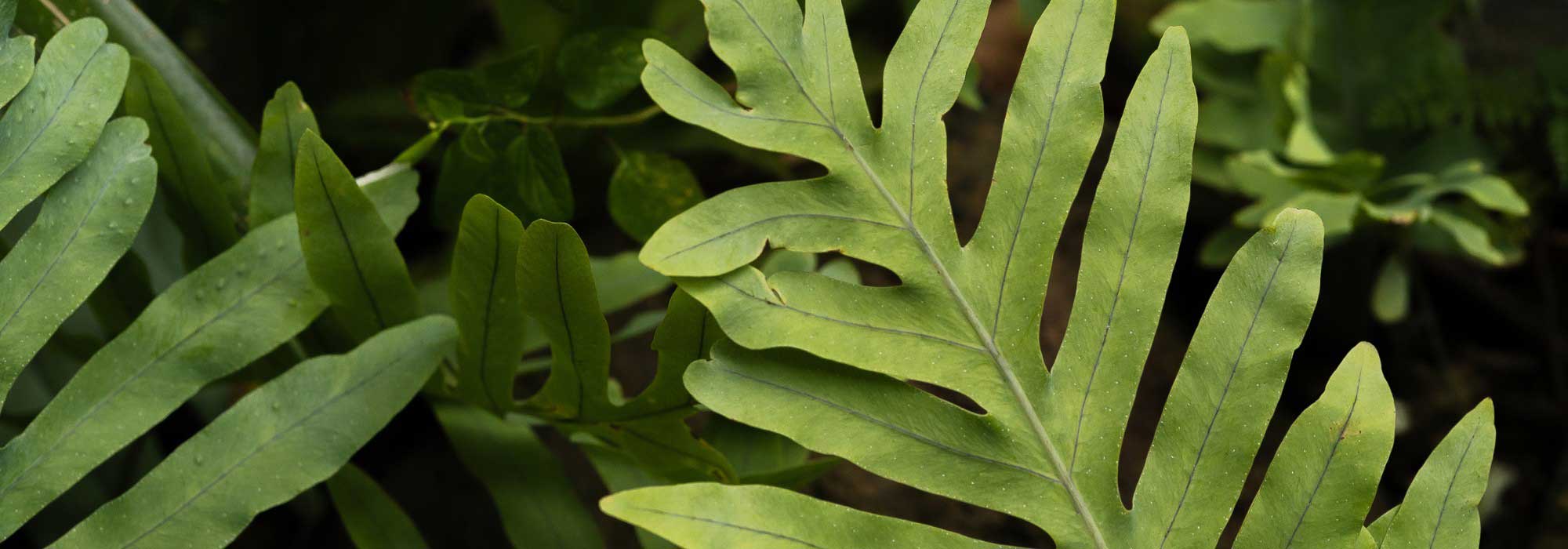
Phlebodium, Blue Fern : cultivation and care
Contents
The Phlebodium in a few words
- The Phlebodium is a popular indoor fern, prized for its unique foliage and elegant habit.
- It originates from the tropical forests of Central and South America, where it grows naturally as an epiphyte on trees.
- Its finely divided, slightly bluish foliage adds a decorative touch all year round.
- It requires minimal maintenance, provided it is given soft light, a well-draining substrate, and good ambient humidity.
- Its fronds tend to cascade over the edges of the pot, making it highly decorative when hung.
The word from our expert
An elegant and graphic houseplant, the Phlebodium, also known as the “blue fern” or sometimes “golden fern”, captivates with its undulate foliage in original hues, ranging from blue-green to metallic grey-green. Belonging to the Polypodiaceae family, this genus of epiphytic fern is native to the tropical and subtropical regions of Central and South America.
Thanks to its decorative appearance and relatively easy care, the Phlebodium is enjoying renewed popularity in modern interiors. It easily finds its place in living rooms, offices, or conservatories, where it adds a touch of freshness and exoticism. It is easy to grow but requires a bright location without direct sunlight, well-drained soil, and good ambient humidity. Discover everything you need to know about the Phlebodium: the best varieties, how to plant and repot it, and all our tips for its care!
Botany and description
Botanical data
- Latin name Phlebodium aureum, Phlebodium pseudoaureum
- Family Polypodiaceae
- Common name Golden polypody, Blue fern, Rabbit's foot fern
- Flowering None
- Height Up to 80 cm
- Sun exposure Bright but without direct sunlight
- Soil type Fertile, moist and well-drained
- Hardiness Frost-tender (minimum 10 °C)
Phlebodium is a perennial fern belonging to the large Polypodiaceae family, which includes many epiphytic ferns — meaning they naturally grow on other plants, particularly on tree trunks, without being parasitic. This lifestyle allows Phlebodium to occupy unique ecological niches in tropical forests, often at height, seeking light and humidity.
Phlebodium is native to tropical and subtropical regions of the American continent, particularly Central America, the southeastern United States, and some Caribbean islands. In its natural habitat, it often grows in humid forests, clinging to tree trunks or branches, benefiting from a warm, humid, and shaded climate.
As a tropical plant, Phlebodium is not hardy and does not tolerate low temperatures. It is generally recommended to grow it indoors or in a greenhouse, especially in regions where temperatures drop below 10°C. Ideally, it thrives between 18 and 25°C. It dislikes cold drafts and sudden temperature changes.
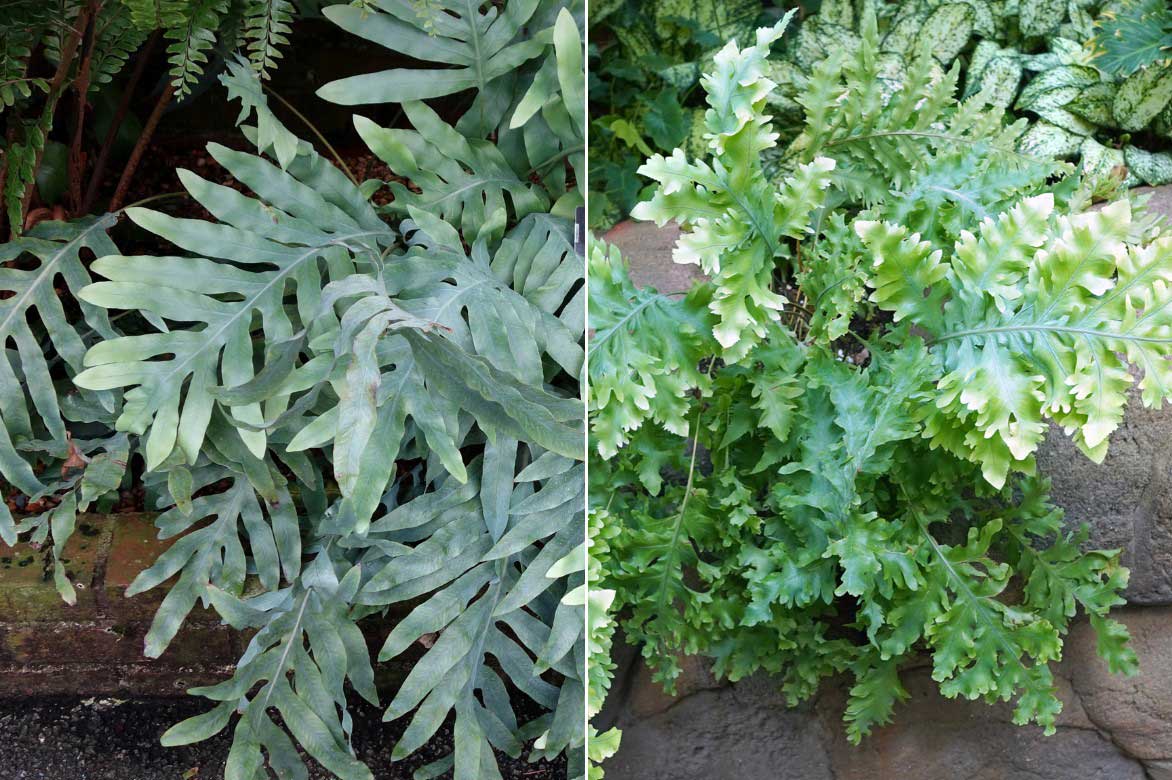
Phlebodium aureum ‘Blue Star’ and ‘Davana’
The Phlebodium genus includes only a few species. Phlebodium aureum is by far the most widely cultivated. Native to the tropical forests of America, it is also sometimes called the “golden fern” in reference to the golden hue of its rootstock. It is recognisable by its large lobed fronds with an arching habit, often tinged with its famous metallic blue-green colour. It comes in several varieties: ‘Blue Star’, with very bluish foliage, almost powdery, and rounded lobes, ‘Davana’, a recent variety with even more finely cut and graphic foliage, intense blue-grey, and a very elegant trailing habit, and ‘Mandianum’, less well-known, offering a light silhouette and foliage with more golden reflections.
Phlebodium pseudoaureum is very similar to P. aureum, but it is less common in cultivation. It differs slightly in foliage colour (more light green than blue) and generally has finer fronds. It is sometimes considered a natural variation or a subspecies. It is mainly found in subtropical zones, particularly in Florida.
Phlebodium develops from a creeping, thick rootstock, often covered in golden scales, hence its nicknames “golden fern” or “rabbit’s foot fern”. From this rootstock emerge long, arching fronds that can reach 50 cm to 1 m in length depending on growing conditions and species. The fronds are divided into fine, elongated lobes. They are only once divided, unlike many ferns whose fronds are divided two or three times. Its habit is flexible, slightly trailing, making it an excellent hanging plant or one to place high up to showcase its foliage.
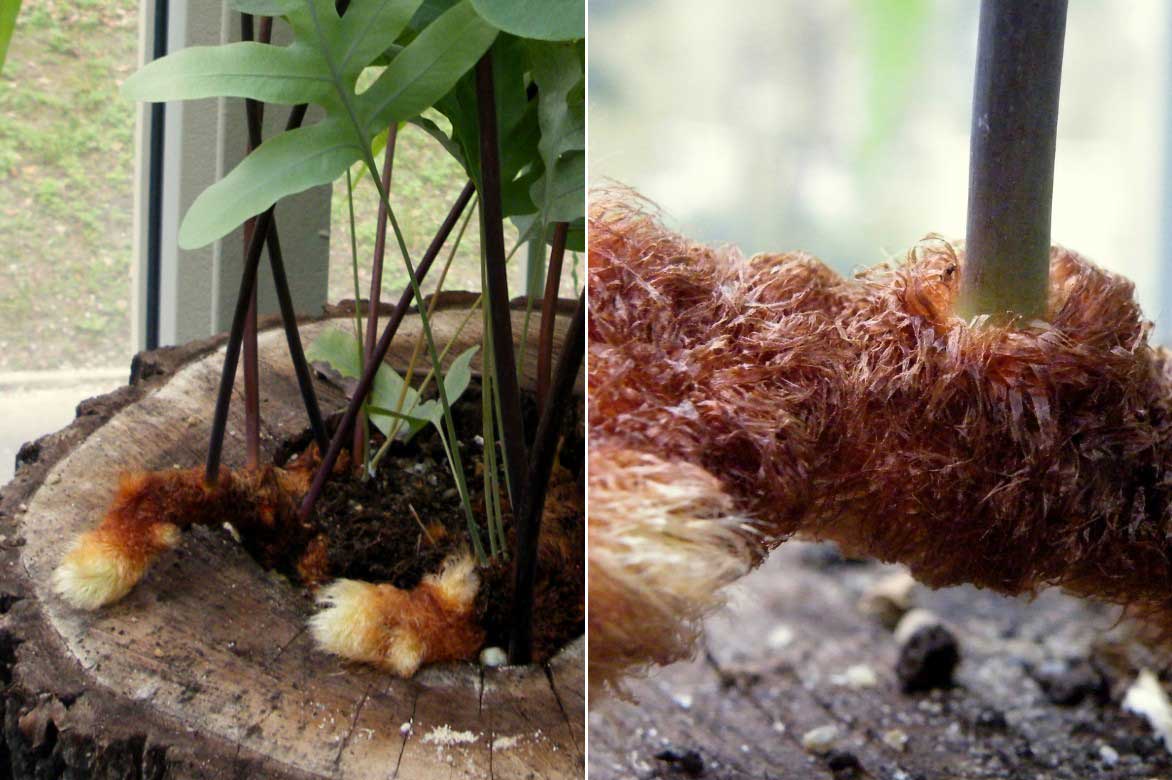
Phlebodium forms rootstocks covered in golden-brown scales, which creep along the soil surface (photos: Marija Gajić)
The foliage is Phlebodium’s charming asset. Its evergreen fronds, leathery, are more or less deeply cut depending on the variety. Their characteristic colour ranges from blue-green to metallic grey-green, sometimes dusted with silvery reflections. This unique hue gives it an almost unreal appearance, making it a highly sought-after plant for interior decoration.
Unlike many other ferns, Phlebodium has foliage that appears almost “waxy” and remains attractive all year round, provided it benefits from good ambient humidity.
Phlebodium, like all ferns, does not flower or produce seeds. Instead, it produces spores, contained in sporangia grouped in circular clusters on the underside of the leaves. These tiny spores, similar to dust, allow the plant to reproduce.
Its growth is rather moderate. It does not become invasive and remains manageable indoors. However, a mature plant can take up considerable space if it thrives, forming a dense, eye-catching clump.
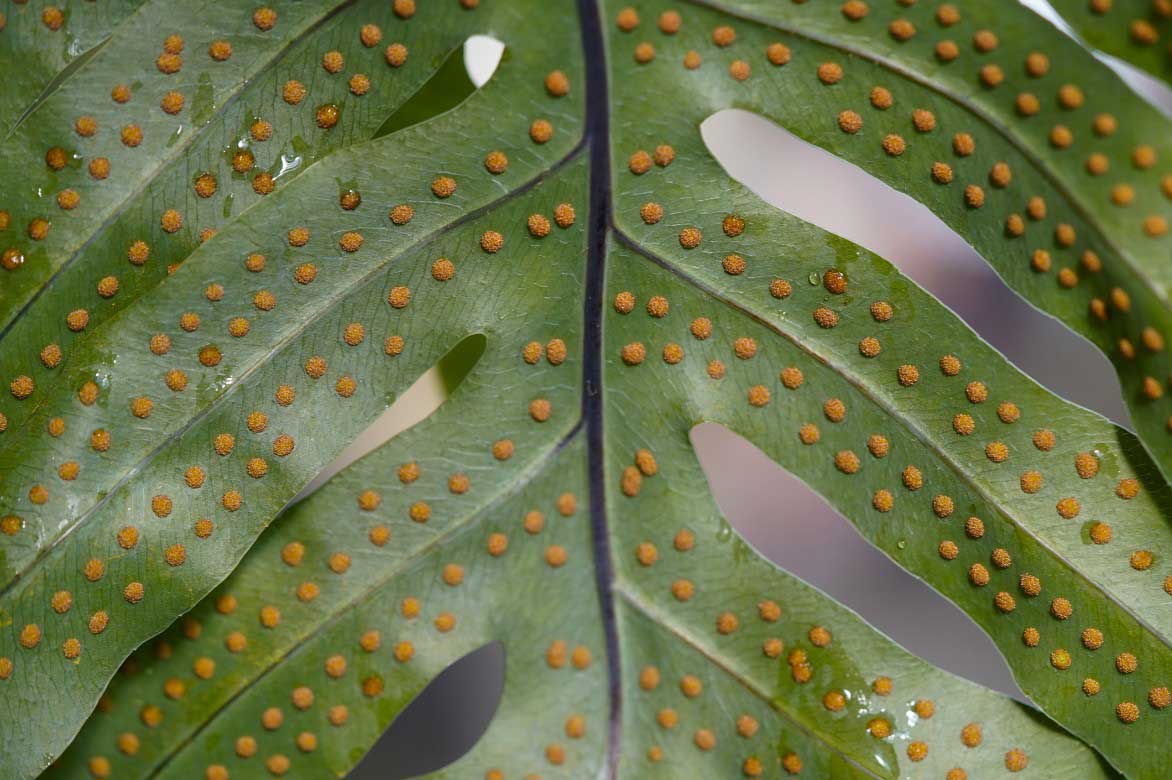
On the underside of Phlebodium fronds, you may sometimes observe orange, circular clusters: these are spores, consisting of numerous sporangia, small spherical sacs containing the spores. At maturity, the sporangia open to release the spores, allowing the plant to multiply.
The main species and varieties
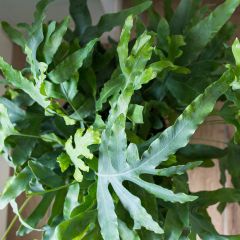
Polypodium pseudoaureum
- Hauteur à maturité 1 m
Planting the Phlebodium
Where to place the Phlebodium?
The Phlebodium is an ideal indoor plant, especially in temperate climates where it wouldn’t survive outdoors. Its location should provide conditions close to its natural habitat in terms of warmth, humidity, and light.
As for exposure, the Phlebodium enjoys brightness but dislikes direct sunlight. A spot with indirect light, near a sheer-curtained window or one facing north or east, suits it perfectly. Too little light can slow its growth and dull its foliage, while direct sunlight can cause burns.
It thrives in a humid atmosphere and will particularly enjoy a bright bathroom, but you can also mist its foliage regularly or place it near a humidifier or on a tray of damp clay pebbles.
The ideal temperature ranges between 18 and 25°C. It dislikes cold drafts and sudden temperature changes. In the warmer months, it can be moved outdoors to a shaded and sheltered spot, but always protected from wind and brought back inside when temperatures drop below 15°C.
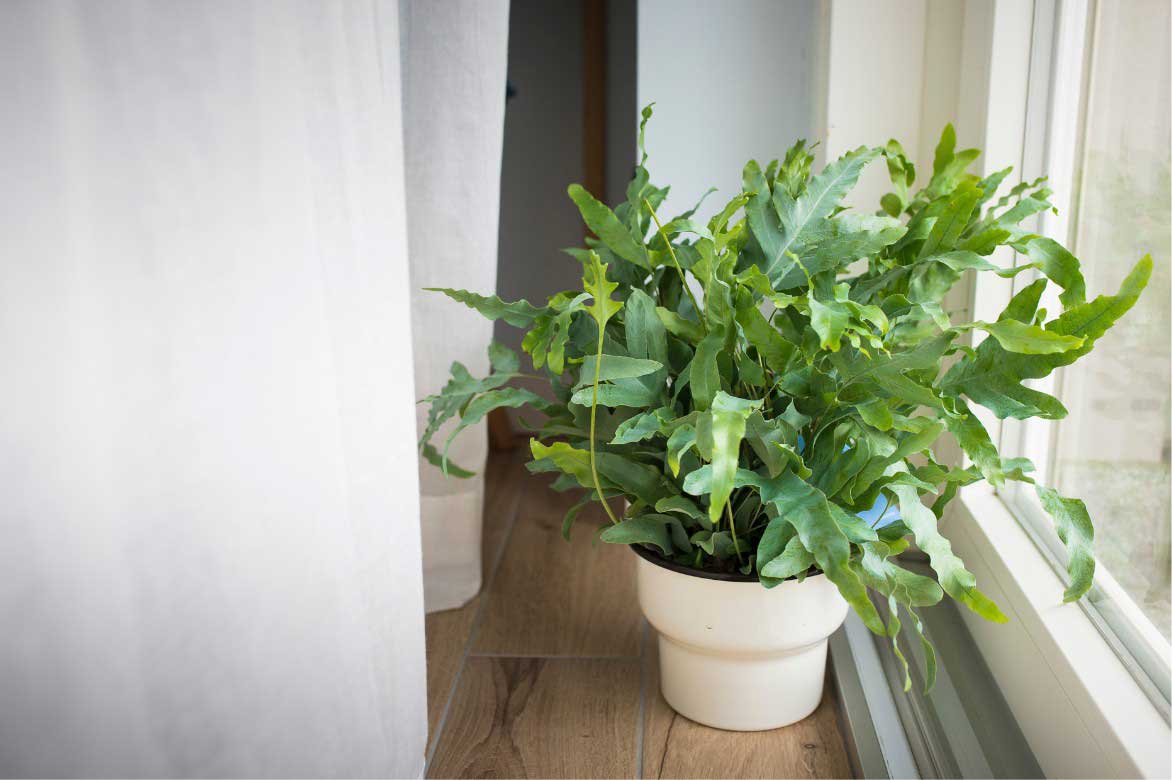
Place the Phlebodium in a bright location, but away from direct sunlight, for example behind a north-facing window.
When to plant the Phlebodium?
The best time to plant or repot a Phlebodium is in spring, between March and May. During this period, the plant emerges from its winter dormancy and enters an active growth phase, making it easier to adapt to a new pot and substrate. Avoid repotting in winter or autumn, except in emergencies (such as a pest attack or a broken pot), as the plant is more vulnerable.
How to plant the Phlebodium?
As the Phlebodium is an epiphytic fern with a rootstock, it requires a well-aerated and draining substrate, but one that can retain some moisture. You can create a mix composed of 1/3 potting soil for houseplants, 1/3 orchid compost (or pine bark), and 1/3 perlite or coarse sand.
Opt for terracotta pots for better root aeration, or lightweight plastic if you’re hanging it. The pot should, of course, have drainage holes at the bottom to prevent waterlogging.
Here are the key steps for successful planting:
- Fill a pot with a light and well-draining substrate.
- Gently remove the Phlebodium from its original pot, taking care not to damage the roots too much.
- Position the plant in the pot, ensuring the rootstock is level with the substrate surface (it shouldn’t be completely buried).
- Fill in by adding more compost around the root ball.
- Lightly firm the soil and water moderately to moisten without soaking.
- Place the plant in its final position, in soft light and a humid environment.
- Wait a few days before fertilising, giving it time to adjust to its new surroundings.
How to care for the Phlebodium?
Caring for the Phlebodium is relatively simple, provided its essential needs are met, primarily linked to its tropical origin. This fern thrives in humid environments, filtered light, and stable temperatures. To keep it healthy and enjoy lush foliage, a few regular steps are sufficient.
Watering
The Phlebodium requires a substrate that remains slightly moist but never waterlogged. It is therefore important to carefully measure water intake. During the growth period, typically from spring to autumn, one to two waterings per week are sufficient, depending on the ambient temperature. In winter, the frequency should be reduced, often to one watering every ten to fifteen days. It is also preferable to use non-calcareous water at room temperature, such as rainwater or filtered water. Excess water can lead to rootstock rot, so it is essential to allow the water to drain after each watering and never leave stagnant water in the saucer.
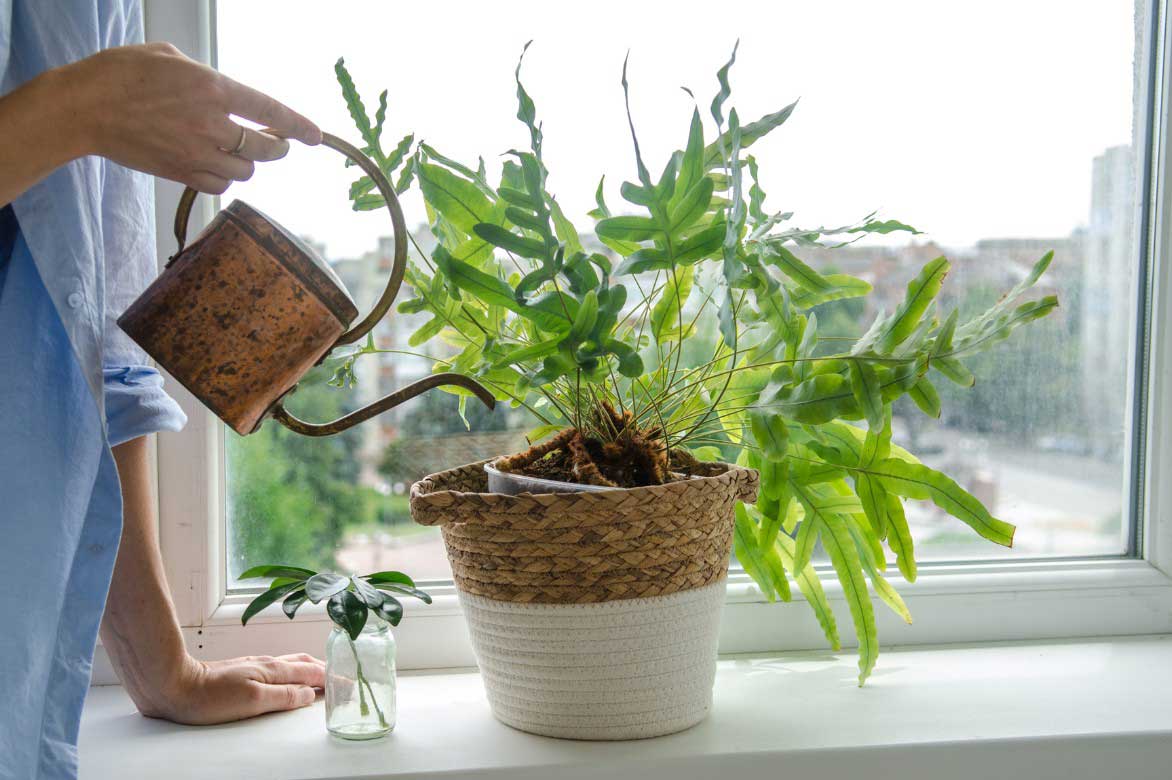
Remember to water the Phlebodium regularly
Humidity
Air humidity is another fundamental factor for the well-being of this fern. Native to humid forests, the Phlebodium appreciates a moist atmosphere. In dry indoor environments, especially in winter when heating is on, it is advisable to regularly mist the foliage with soft water or place the pot on a bed of damp clay pebbles. In very dry rooms, a humidifier can be an effective solution to maintain sufficient humidity.
Fertilisation
To stimulate its growth during the growing season, a moderate supply of fertiliser is beneficial. You can add a liquid fertiliser for green plants, diluted in the watering water, once a month between April and September. However, it is unnecessary, even harmful, to fertilise during winter when the plant is dormant.
Pruning and Cleaning
Finally, a little aesthetic maintenance will keep your Phlebodium in top shape. Simply remove dried fronds regularly at their base and dust the foliage with a soft, damp cloth. You can also give your plant a lukewarm shower under the showerhead once a month, which will help remove dust and refresh its leaves.
What are the diseases and parasitic pests of Phlebodium?
The main threat to the Phlebodium is stagnant moisture, which can lead to the development of rootstock or root rot. This type of issue often manifests as rapid yellowing of the foliage, a general drooping of the plant, and sometimes an unpleasant odour emanating from the soil. In this case, it is essential to act quickly: remove the plant from its pot, eliminate the rotten parts, and repot it in a healthy, well-draining substrate. A reduction in watering frequency will also be necessary.
Another common issue indoors is dry air, especially in winter. When ambient humidity is too low, the Phlebodium may suffer from drying at the tips of its fronds or even complete browning of the leaves. Additionally, dry air encourages the appearance of certain parasites, notably red spider mites. These tiny mites, difficult to see with the naked eye, are indicated by fine webbing on the underside of the leaves and a stippled appearance of the foliage, which becomes dull and speckled. To prevent or treat them, increasing ambient humidity is often sufficient. In the case of a more serious infestation, you can spray a natural insecticidal solution based on black soap or neem oil.
The Phlebodium can also be targeted by mealybugs, which often lodge at the base of the fronds or along the rootstock. They resemble small white cottony balls. To eliminate them, you can remove them by hand with a cotton swab soaked in 70% alcohol or use a natural anti-mealybug treatment.
Finally, cultivation mistakes can sometimes lead to symptoms that are not strictly related to a disease. For example, pale or sparse foliage may indicate a lack of light, while slowed growth or an absence of new fronds may suggest a nutrient deficiency or depleted substrate. In these cases, adjusting the growing conditions is usually enough to restore the plant’s balance.
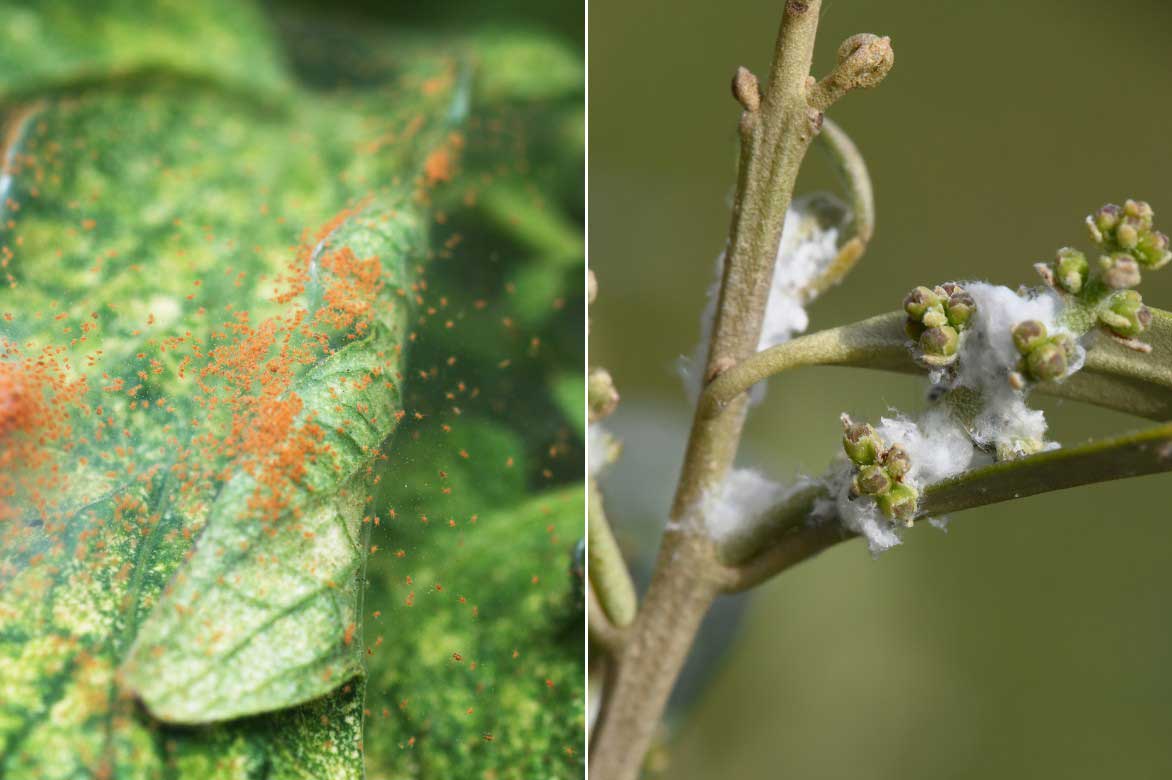
Red spider mites and mealybugs
How to propagate Phlebodium?
Unlike other ferns that primarily propagate via spores (a more complex and lengthy process), the Phlebodium can be propagated by dividing the rootstock, a simple and effective method.
The best time to attempt propagation is in spring, when the plant resumes its growth. This period offers optimal conditions for successful establishment, as the plant is more vigorous and receptive to handling.
- Choose a healthy, well-developed plant with several fronds already formed and, if possible, visible buds on the rootstock.
- Carefully dig up the parent plant to access the rootstock, this creeping stem that runs just below or at the surface of the substrate.
- Using a well-disinfected tool (knife or pruning shear), cut a portion of the rootstock, ensuring each section retains at least one growth point and a few roots.
- Replant each rootstock section in a pot with a light, well-draining substrate, similar to the one used for the parent plant (a mix of potting soil for houseplants, perlite, and bark). It is crucial not to bury the rootstock completely, as it should remain partially above the surface.
- Water lightly to rehydrate the roots without saturating the mixture.
During the first few weeks, the young divisions should be placed in a warm, bright environment without direct sunlight, and most importantly, humid, to encourage establishment. Feel free to cover the pots with a transparent plastic bag to maintain humidity, but remember to ventilate regularly to prevent mould.
Patience is key: it may take several weeks before new fronds appear. But once well-rooted, each division will become a full-fledged plant, as robust and decorative as the original.
How to highlight the Phlebodium and which plants to pair it with?
The Phlebodium pairs beautifully with other tropical plants that thrive in humidity. For example, you can pair it with Calatheas, with their graphic patterns and varied hues, or with Fittonias. Their colourful foliage contrasts beautifully with the softer leaves of the Phlebodium. Marantas or Peperomias can also complement the scene nicely, adding different shapes and textures without stealing the spotlight from the fern.
To play with contrasts in shape and habit, it’s also very interesting to combine the Phlebodium with plants featuring more structured foliage, such as Philodendrons, Monstera, or Alocasias. These large, smooth, and glossy leaves highlight the finely divided and powdery-coloured fronds of the Phlebodium. These plants also share the same preferences in terms of light and humidity, making them easier to care for as a group.
The Phlebodium looks stunning in a hanging pot, where its trailing fronds can spread freely. For a more jungle-like atmosphere, it can also be integrated into a large container with other tropical plants or placed on a mid-height shelf to showcase its airy silhouette.
Finally, for a very natural-style decoration, you can pair it with elements made of wood, raw ceramic, or wicker, which evoke forest materials. A display with a few pebbles, pieces of driftwood, or stabilised moss will create a zen and relaxing ambiance.
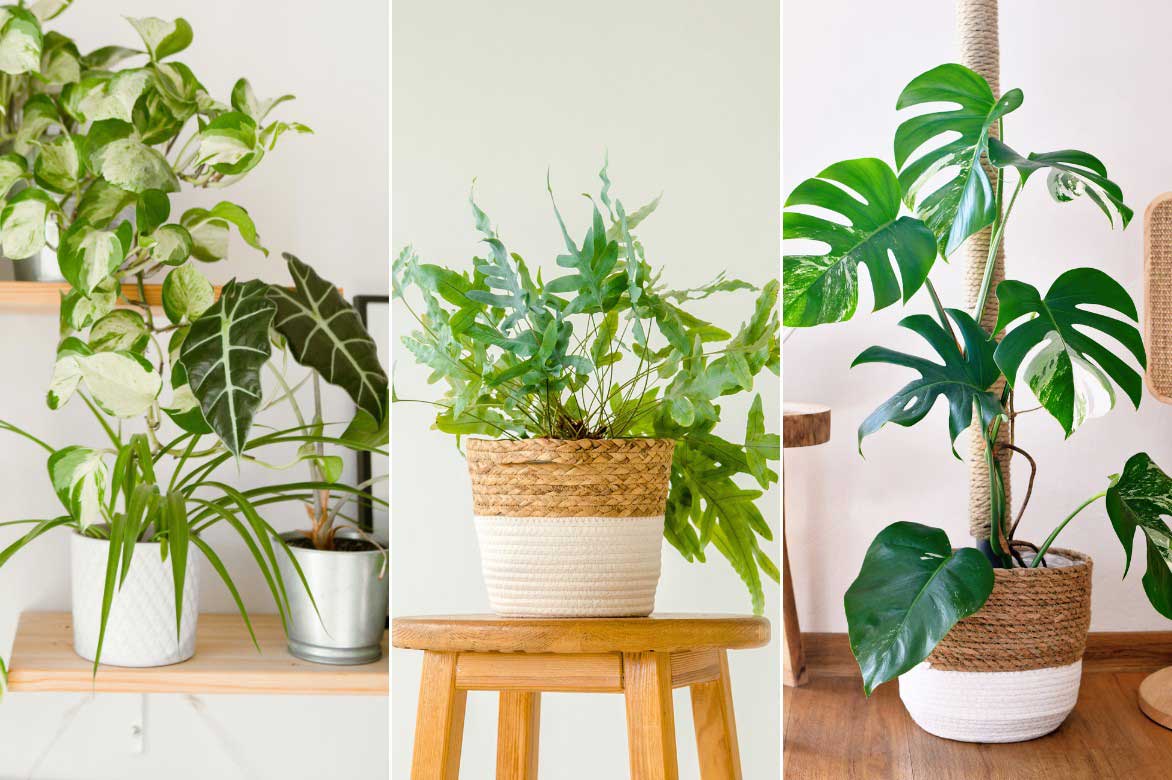
Pair the Phlebodium with other houseplants such as Chlorophytums, Pothos, Alocasias, and Monsteras. Opt for planters and decorative elements in light, natural tones like wood, white, beige, or cream…
Also worth reading
- Discover our full range of houseplants
- Our books on houseplants
- Subscribe!
- Contents
































Comments